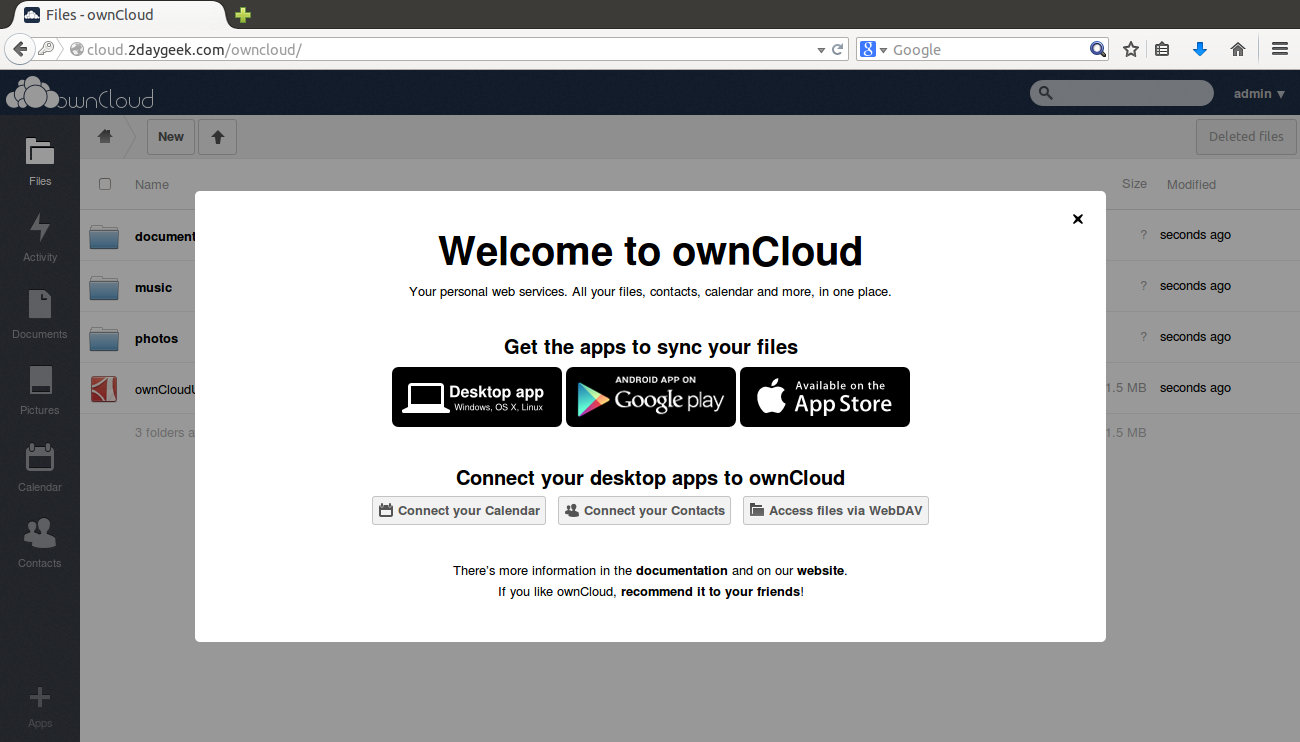

- #Owncloud 9 install install
- #Owncloud 9 install archive
- #Owncloud 9 install password
- #Owncloud 9 install download
Ssl_certificate_key /usr/local/etc/self-cert/owncloud.key Ssl_certificate /usr/local/etc/self-cert/owncloud.crt First thing's first -make a backup of nf. For this example because we used self-signed keys, nginx is going to be configured to use SSL. Let's setup nginx as our webserver for owncloud. This will enable Nginx to start automatically on your server during boot time. Set permissions of your owncloud directory:Įcho 'nginx_enable="YES"' > /etc/rc.conf
#Owncloud 9 install archive
Now that you've unpacked or unzipped your archive in /tmp/, we need to move our owncloud directory to its final destination:Ĭreate your owncloud webserver root path:Ĭopy the owncloud directory from /tmp/ to your newly created webroot:Ĭhange ownership of your owncloud directory: Unzip owncloud-9.1.0.zip # Note: You must have the package unzip installed to unzip a.
#Owncloud 9 install download
Depending on which type of owncloud download archive chose, use either of the following commands: Gpg -verify owncloud-9.1.0. owncloud-9.1.0.tar.bz2Įverything looks good? Great! Next, let's extract the archive contents.
#Owncloud 9 install install
Pkg install php70-curl php70-mcrypt php70-zip php70-xmlrpc php70-xml php70-imap php70-json php70-pgsql php70-opcache php70-gmp php70-gd php70-ldap php70-intl php70-openssl php70-exif php70-extensions php70-pdo_pgsql php70-bz2 php70-zlib php70-fileinfo php70-mbstring Template1 | pgsql | UTF8 | C | C | =c/pgsql + Template0 | pgsql | UTF8 | C | C | =c/pgsql + Name | Owner | Encoding | Collate | Ctype | Access privileges Owncloud=# ALTER DATABASE owncloud OWNER TO owncloud

Owncloud=# ALTER ROLE owncloud WITH LOGIN
#Owncloud 9 install password
The share can be undone at any time by unchecking the “Share link” checkbox under the file’s “Sharing” side panel on the source ownCloud server.Owncloud=# ALTER ROLE owncloud WITH PASSWORD 'oc5678' If successful, the remote user will be able to see the shared file under the “Files -> Shared with you” menu item on the remote ownCloud server. The recipient may need to log in to the destination ownCloud server and confirm the share operation as part of the process. The source ownCloud server will attempt to connect to the destination ownCloud server and share the selected file. On the resulting page, click the “Add to your ownCloud” button and enter the URL of the destination ownCloud server (the server the file should be shared with). The recipient of the URL must perform the following steps: Send this URL to the user you wish to share the file with. In the “Sharing” side panel, tick the “Share link” checkbox and copy the resulting URL. Click the “Share” icon next to the filename. Use the “Files -> All files” menu item to find the file you wish to share. To use this feature, ensure that you have a running ownCloud server and the details of another ownCloud server you wish to connect to, and then follow the steps below: NOTE: Federated sharing requires all involved ownCloud servers to be public, so that they can communicate with each other. Federated sharing is enabled by default in ownCloud 9 and better. OwnCloud supports “federated sharing”, which essentially means connecting an ownCloud server with other ownCloud servers to enable sharing between them.

Learn more about the Bitnami stack environment and about OS X VMs. On OS X VMs, the installation directory is /opt/bitnami and OS X VM users can click the “Open Terminal” button to run commands. Before running the commands shown on this page, you should load the Bitnami stack environment by executing the installdir/use_APPNAME script (Linux and MacOS) or by clicking the shortcut in the Start Menu under “Start -> Bitnami APPNAME Stack -> Application console” (Windows).


 0 kommentar(er)
0 kommentar(er)
